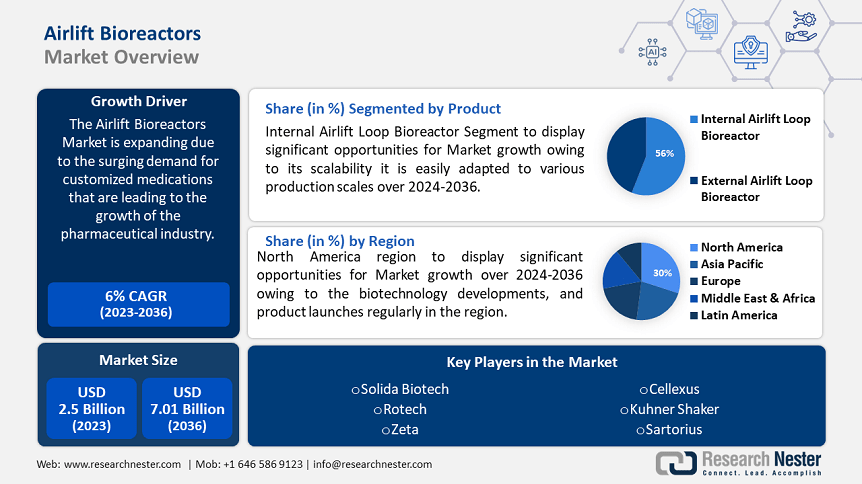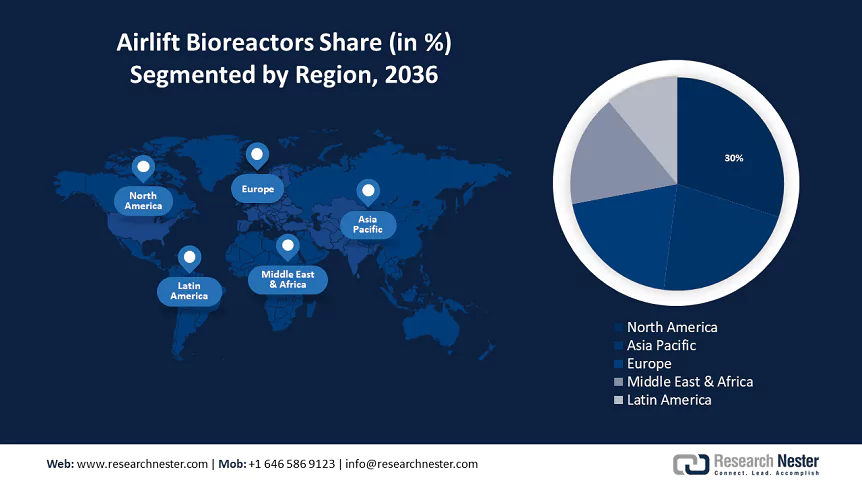
Airlift Bioreactors Market size is predicted to reach USD 7.01 Billion by the end of 2036, growing at a CAGR of 6% during the forecast period, i.e., 2024-2036. In the year 2023, the industry size of airlift bioreactors was over USD 2.5 Billion. This growth is due to the rising need for customized medications leading to the growth of the pharmaceutical industry.
The Congressional Budget Office reports that the pharmaceutical industry invested USD 83 billion in research and development in 2019. In addition, it is assessed that India's pharmaceutical sector will generate USD 130 billion by 2030 and USD 65 billion by 2024. Furthermore, Canada ranks eighth in the world for pharmaceutical sales, accounting for 2.2% of the global market.
The growth in the airlift bioreactor market in the near future can be attributed to advancements in healthcare technology. Growing output of various research and development of biochemicals and its activities are expected to present profitable growth prospects for the biochemical industry.

Growth Drivers
Challenges
|
Base Year |
2023 |
|
Forecast Year |
2024-2036 |
|
CAGR |
6% |
|
Base Year Market Size (2023) |
USD 2.5 Billion |
|
Forecast Year Market Size (2036) |
USD 7.01 Billion |
|
Regional Scope |
|
Product (Internal Airlift Loop Bioreactor, External Airlift Loop Bioreactor)
In airlift bioreactors market, internal airlift loop bioreactor segment is poised to dominate over 56% share by 2036. Numerous industries have begun to use and pay attention to bioreactors. These bioreactors are well-liked and dominate the market because they provide special benefits. They offer effective mass transport of gases and nutrients as well as good liquid phase mixing.
Because of their considerable scalability, internal airlift loop bioreactors can be easily adapted to various production scales. The market landscape is also influenced by recent developments, changing uses, and rising technology.
End-User (Biopharmaceutical Companies, CRO/CDMO, Research & Development Companies)
In airlift bioreactors market, biopharmaceutical companies segment is estimated to account for around 53% revenue share by 2036. The demand for customized medicine, the rising incidence of chronic diseases, and innovative therapies have all contributed to the biopharmaceutical industry's recent significant rise.
These businesses frequently need scalable manufacturing solutions to keep up with the demands of their expanding commercial production needs. For biopharmaceutical businesses looking to go from laboratory-scale to commercial-scale production, airlift bioreactors offer an appealing alternative due to their scalability and capacity to maintain stable hydrodynamic conditions during scale-up. Aside from this, airlift bioreactors help biopharmaceutical businesses achieve their goals by offering ideal conditions for cell development and product creation. These organizations place a high priority on protecting the integrity and purity of their goods.
Our in-depth analysis of the global market includes the following segments:
|
Product |
|
|
Capacity |
|
|
Material |
|
|
Usage |
|
|
End User |
|
North American Market Forecast
By 2036, North America region is expected to dominate over 30% Airlift bioreactors market share. Product launches regularly, biotechnology developments, and other encouraging elements propel the industry in this region.
The United States alone accounts for about one-third of the worldwide biopharmaceutical industry and leads in biopharmaceutical R&D, demonstrating the region's strong infrastructure for biopharmaceutical manufacturing. For instance; the Pharmaceutical Research and Manufacturers Association (PhRMA) estimates that more than any other industry in the United States in 2017, biopharmaceutical companies invested around USD 97 billion in research and development (R&D). These mostly foreign-owned companies invested roughly USD 20 billion in R&D in the same year. The adoption of airlift bioreactors is fueled by the substantial investments in the biotechnology and pharmaceutical sectors that this rich ecosystem draws.
APAC Market Statistics
By 2036, Asia Pacific Region in airlift bioreactors market is anticipated to dominate over 22% revenue share. Its rise is driven by the increase in demand for bio-based products such as bio-based leather, which is especially evident in China given its emphasis on ethanol production.
Improved mass transfer and increased oxygen transfer rates are two of the unique benefits that make airlift bioreactors a desirable option for bio-based manufacturing in the region. This crucial component is foreseen to fuel revenue growth in the Asia Pacific market, solidifying its standing as a major force behind the advancement of the sector.


Author Credits: Radhika Pawar
Copyright © 2024 Research Nester. All Rights Reserved

FREE Sample Copy includes market overview, growth trends, statistical charts & tables, forecast estimates, and much more.
Have questions before ordering this report?